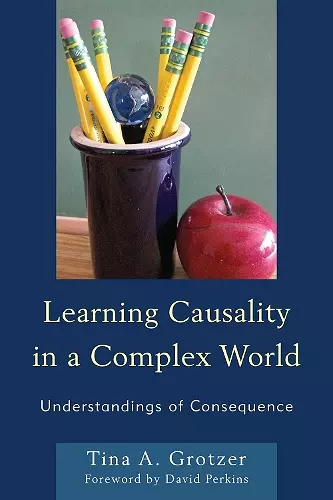Learning Causality in a Complex World
Understandings of Consequence
Format:Paperback
Publisher:Rowman & Littlefield
Published:28th Jun '12
Currently unavailable, and unfortunately no date known when it will be back
This paperback is available in another edition too:
- Hardback£76.00(9781610488631)

What do children’s interactions on the playground have to do with foreign policy? How does science understanding in middle school relate to environmental disasters in third world countries? The causal patterns that we detect and how we act upon them pervade every aspect of our lives. These skills will only become more important in the future as our world becomes more global and more interconnected. Yet we aren’t very skilled at thinking about causality. Research shows that instead we rely on limiting default assumptions that can lead to poor choices in a complex world. What can we do about it? This book offers ways to become aware of these patterns and to reframe our thinking to become more effective learners and citizens of the world. Through examples and accessible explanations, it offers a causal curriculum to enable more effective learning so that we can put the power of better causal understanding to work for ourselves and the next generation— for today and tomorrow.
The ability to understand complex causal relations in the world is becoming ever more important for students, workers, and leaders. For many years, Tina Grotzer, one of the nation’s leading researchers on the development of scientific thinking, has focused her work on this cognitive capacity; she has done more than anyone to elucidate how such complex forms of thinking can be acquired. Her book on this topic will be of great interest to researchers, educators, parents, and others who want to see our children use their minds well. -- Howard Gardner, Hobbs Professor of Cognition and Education, Harvard Graduate School of Education
As humanity struggles to control it's self-destructive impacts on the natural world, Professor Grotzer's seminal book, teaching us all how better to understand and perhaps predict the consequences of our actions, could not come at a more critically important time. -- Eric Chivian, Director, Center for Health and the Global Environment, Harvard Medical School
Cause and effect is usually considered as the relationship between one event (the cause) and the consequence of that event (the effect). There are no intervening factors: one thing makes another happen. Grotzer (Harvard Graduate School of Education) uses this simple linear causality, which most readers understand, as a comparison for five more causal patterns that she has identified through research: domino causality (effects that become causes), cyclic causality (loops and feedback), spiraling causality (escalation and de-escalation), mutual causality (symbiosis and bi-directionality), and relational causality (balances and differentials across time and distance). A teacher's understanding of these various causality patterns, in light of the 21st-century skill emphasis on critical thinking, would go a long way in helping students move beyond simplifying default assumptions. Understanding causal patterns, their characteristics, and why it is important to attend to this type of student thinking advances the development of scientific thinking in learners. However, the explanations of these patterns are overly complex and perhaps better suited for a researcher audience than a teacher audience. Summing Up: Recommended. Graduate, research, and professional collections. * CHOICE *
ISBN: 9781610488648
Dimensions: 228mm x 152mm x 13mm
Weight: 322g
208 pages